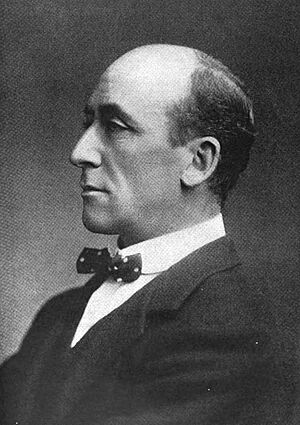Algernon Blackwood facts for kids
Quick facts for kids
Algernon Blackwood
|
|
|---|---|
 |
|
| Born | Algernon Henry Blackwood 14 March 1869 Shooter's Hill, Kent, England |
| Died | 10 December 1951 (aged 82) London |
| Occupation | Writer, broadcaster |
| Genre | Fantasy, horror, weird fiction |
| Notable works | The Centaur, "The Willows", "The Wendigo" |
Algernon Henry Blackwood (born March 14, 1869 – died December 10, 1951) was an English writer. He was known for his many ghost stories and other tales of the supernatural. People often say he was one of the best "weird fiction" writers. This means his stories explored strange and mysterious ideas.
Life and Adventures
Algernon Blackwood was born in Shooter's Hill, England. This area is now part of London. He went to Wellington College for his education. His father worked for the Post Office. His mother was interested in different spiritual ideas. Algernon also became very interested in Buddhism and other Eastern philosophies.
Blackwood had many different jobs throughout his life. He was a dairy farmer in Canada. He also ran a hotel there for a while. He worked as a newspaper reporter in New York City. He was even a bartender, a model, and a violin teacher! In Canada, he helped start a group called the Theosophical Society. This group studied different religions and philosophies.
When he was in his late thirties, Blackwood moved back to England. This is when he started writing stories about the supernatural. He became very successful. He wrote at least ten collections of short stories. He also told his stories on radio and television. He wrote 14 novels and several books for children.
Algernon Blackwood loved nature and being outdoors. Many of his stories show this love. He also joined a group called The Ghost Club. This club investigated ghost stories and strange events. He never married and was known for being a bit of a loner. But his friends said he was also cheerful.
A writer named Jack Sullivan said that Blackwood's life was like his stories. He was a mix of a mystic and an outdoorsman. When he wasn't studying hidden knowledge, he was often skiing or mountain climbing. Blackwood was also part of a group called the Hermetic Order of the Golden Dawn. This group studied magic and spiritual ideas.
His two most famous stories are "The Willows" and "The Wendigo". Blackwood often wrote stories quickly for newspapers. Because of this, he wasn't even sure how many short stories he had written!
Many of Blackwood's stories don't just try to scare you. They often try to make you feel a sense of wonder and awe. For example, his novel The Centaur describes a traveler seeing a herd of mythical creatures. His books Julius LeVallon and The Bright Messenger explore ideas like reincarnation. They also look at how human minds might evolve in new, mystical ways.
Blackwood once wrote about his main interest. He said he wanted to find signs of "other powers that lie hidden in us all." He believed our minds could change and grow. He thought this change could help us discover a "new universe."
About His Life
Algernon Blackwood wrote a book about his early life. It is called Episodes Before Thirty (1923). There is also a book about his life called Starlight Man by Mike Ashley.
His Final Days
Algernon Blackwood passed away on December 10, 1951. He had several strokes. A few weeks later, his nephew took his ashes to the Swiss Alps. He scattered them in the mountains that Blackwood had loved for over forty years.
His Lasting Influence
- The famous horror writer H. P. Lovecraft thought Blackwood was one of the "Modern Masters" of weird fiction.
- Many authors have been influenced by Blackwood's work. These include William Hope Hodgson, Ramsey Campbell, and Graham Joyce.
- J. R. R. Tolkien, who wrote The Lord of the Rings, said he got the phrase "crack of doom" from one of Blackwood's stories.
- The PS4 game Until Dawn has a main setting called Blackwood Pines. This is because the main monster in the game is a Wendigo, which Blackwood wrote about.
- Algernon Blackwood even appears as a character in the novel The Curse of the Wendigo by Rick Yancey.
See Also
 In Spanish: Algernon Blackwood para niños
In Spanish: Algernon Blackwood para niños
- List of horror fiction authors
- Religion and mythology
- Tales of Mystery, a 1960s British supernatural television drama series
- Weird Fiction

